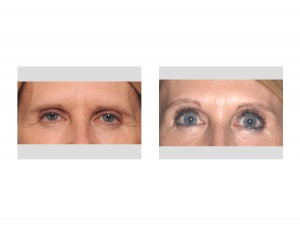
But lifting of the eyebrows is more than just making them higher. It is not just a function of making them as high as the tissues will allow. If the brows are lifted too high, one will get the classic ‘deer in the headlights’ look. Browlifting should focus on brow reshaping as much as just simple elevation. The shape of the eyebrows (arch) is often just as important as its actual position on the bone for creating a rejuvenated eye appearance.
The eyebrow position and shape has been shown to be just as important on a perception of tiredness as that of eyelid position and number of surrounding wrinkles. In a recent published study which evaluated this concept, a standardized photograph of a youthful upper face was modified using digital imaging software to independently alter a number of variables: brow position/shape, upper/lower lid position, pretarsal show, and rhytides. Subjects were presented with 16 images and asked to quantify on a scale from 0 to 5, the presence of each of seven expressions/emotions from tiredness to happiness. The results showed that the look of tiredness was achieved by changes of increasing and decreasing the upper eyelid skin crease, lowering the upper eyelid, and depressing the angle of the lateral eyebrow. Happiness was perceived by elevation of the lower lid or the presence of crow’s feet. Brow shape had a greater influence than absolute position on perceived expression. Elevation of the lateral brow was perceived as surprise, whereas depression of the medial brow and rhytides at the glabella were perceived as anger and disgust. Elevation of the medial brow elicited a minimal increase for sadness.
This study shows that the perception of tiredness is most likely influenced by the vertical height of the upper eyelid. A ptotic or low hanging upper eyelid (e.g., ptosis) makes one look tired. Modifications of eyebrow shape were shown to have a greater influence on perceived facial mood than the eyebrow position on the bone.
With these study results, it is clear that in browlift surgery it is important to pay attention to the shape of the arch of the eyebrow and not just brow elevation. The widely used endoscopic browlift and the lesser used pretrichial browlift allow for good manipulation of the brow arch through differential forehead skin removal and cranial suspension sutures.
Dr. Barry Eppley
Indianapolis, Indiana


